Food Dishes
Listed are the food dishes specified on the AC syllabus. These are extracts from Wikipedia, with links to the Wikipedia page.
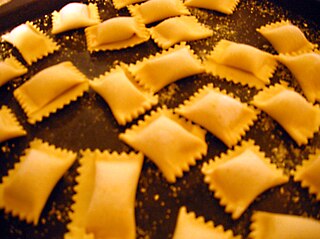
Agnolotti
Agnolotti (Italian: [aɲɲoˈlɔtti]; Piedmontese: agnolòt, Piedmontese: [aɲʊˈlɔt]) is a type of stuffed pasta typical of the Piedmont region of Italy, made with small pieces of flattened dough folded over a filling of roasted meat or vegetables. Agnolotti is the plural form of the Italian word "agnolotto". Agnolotti can be di magro or di grasso depending on their filling of vegetables or meat.
Although their primitive shape was semi-circular, traditionally agnolotti are of a square shape with sides of about one or two inches. However, they can also be of a smaller, rectangular shape when they are called agnolotti al plin. Plin means "a pinch", because one pinches with thumb and forefinger between each mound of filling to close and seal the little pasta packets. Agnolotti al plin are almost always stuffed with meat.
The dish is not to be confused with Piacenza's stuffed pasta pockets called anolini.
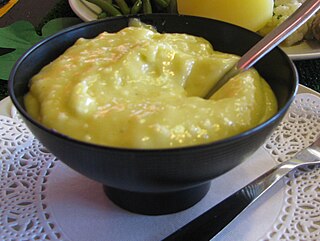
Aioli
Aioli, allioli or aïoli ( or ; Provençal Occitan: alhòli [aˈʎɔli] or aiòli [aˈjɔli]; Catalan: allioli [ˌaʎiˈɔli]; Spanish: alioli [ˌaliˈoli]) is a cold sauce consisting of an emulsion of garlic and olive oil; it is found in the cuisines of the northwest Mediterranean.
The names mean "garlic and oil" in Catalan and Provençal. It is found in the cuisines of the Mediterranean coasts of Spain (Catalonia, the Valencian Community, the Balearic Islands, Murcia, and eastern Andalusia) and France (Provence, Languedoc, Roussilon).
Some versions of the sauce are closer to a garlic mayonnaise, incorporating egg yolks and lemon juice, whereas other versions lack egg yolk and contain more garlic. The latter gives the sauce a pastier texture, making it more laborious to produce as the emulsion is harder to stabilise. There are many variations, such as adding lemon juice or other seasonings. In France, it may include mustard.
In Malta, the term arjoli or ajjoli is used for a different preparation made with galletti (a type of cracker), tomato, onion, garlic and herbs.
Like mayonnaise, aioli is an emulsion or suspension of small globules of oil and oil-soluble compounds in water and water-soluble compounds. Purists believe aioli should not include egg, but nowadays, egg or egg yolk is the usual emulsifier.
Since about 1990, it has become common in the United States to call all flavored mayonnaises aioli. Purists insist that flavored mayonnaise can contain garlic, but true aioli contains garlic and no other seasoning (except salt).

Arepa
Arepa (Spanish pronunciation: [aˈɾepa]) is a type of food made of ground maize dough stuffed with a filling, eaten in northern parts of South America since pre-Columbian times, and notable primarily in the cuisine of Colombia and Venezuela, but also present in Bolivia, Ecuador, and Central America.
Initially, arepa flour was made by grinding maize at home. In the 1950s, precooked arepa flour was invented by Luis Caballero Mejías, a Venezuelan engineer, and became an instant success.
Arepa is commonly eaten in those countries and can be served with accompaniments, such as cheese, cuajada (fresh cheese), various types of meat, avocado, or diablito (deviled ham spread). It can also be split to make sandwiches. Sizes, maize types, and added ingredients vary based on preparation. It is similar to the Mexican gordita, the Salvadoran pupusa, the Ecuadorian tortilla de maíz, and the Panamanian tortilla or changa.
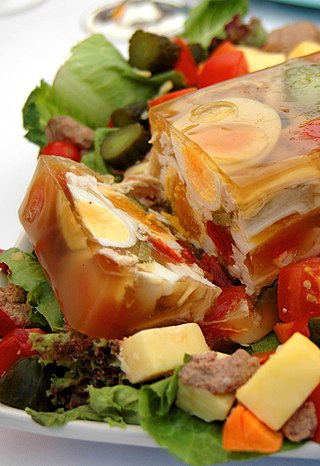
Aspic
Aspic or meat jelly () is a savory gelatin made with a meat stock or broth, set in a mold to encase other ingredients. These often include pieces of meat, seafood, vegetable, or eggs. Aspic is also sometimes referred to as aspic gelée or aspic jelly. In its simplest form, aspic is essentially a gelatinous version of conventional soup.

Baba ghanoush
Baba ghanoush (UK: , US: ; Arabic: بابا غنوج, romanized: bābā ġannūj ), also spelled baba ganoush or baba ghanouj, is a Levantine appetizer consisting of finely chopped roasted eggplant, olive oil, lemon juice, various seasonings, and tahini. The eggplant is traditionally baked or broiled over an open flame before peeling, so that the pulp is soft and has a smoky taste. It is a typical meze ('starter') of the regional cuisine, often served as a side to a main meal and as a dip for pita bread.
A very similar dish is mutabbal (Arabic: متبل lit. 'spiced'). Mutabbal is sometimes said to be a spicier version of baba ghanoush.

Baguette
A baguette (; French: [baɡɛt] ) is a long, thin type of bread of French origin that is commonly made from basic lean dough (the dough, though not the shape, is defined by French law). It is distinguishable by its length and crisp crust.
A baguette has a diameter of about 5 to 6 centimetres (2–2+1⁄2 inches) and a usual length of about 65 cm (26 in), although a baguette can be up to 1 m (39 in) long.
In November 2018, documentation surrounding the "craftsmanship and culture" of making this bread was added to the French Ministry of Culture's National Inventory of Intangible Cultural Heritage. In 2022, the artisanal know-how and culture of baguette bread was inscribed to the UNESCO Intangible Cultural Heritage Lists.

Bánh mì
In Vietnamese cuisine, bánh mì or banh mi (, ; Vietnamese: [ɓǎjŋ̟ mì], 'bread') is a short baguette with thin, crisp crust and a soft, airy texture. It is often split lengthwise and filled with meat and savory ingredients like a submarine sandwich and served as a meal, called bánh mì thịt. Plain bánh mì is also eaten as a staple food.
A typical Vietnamese roll or sandwich is a fusion of meats and vegetables from native Vietnamese cuisine such as chả lụa (Vietnamese sausage), coriander leaf (cilantro), cucumber, pickled carrots, and pickled daikon combined with condiments from French cuisine such as pâté, along with red chili and mayonnaise. However, a wide variety of popular fillings are used, from xíu mại (a Chinese dumpling) to even ice cream. In Vietnam, bread rolls and sandwiches are typically eaten for breakfast or as a snack.
The baguette was introduced to Vietnam by the French in the mid-19th century, during the Nguyễn dynasty, and became a staple food by the early 20th century. In the 1950s, a distinctly Vietnamese style of sandwich developed in Saigon, becoming a popular street food, also known as bánh mì Sài Gòn ('Saigon sandwich' or 'Saigon-style bánh mì'). Following the Vietnam War, overseas Vietnamese popularized the bánh mì sandwich in countries such as Australia, Canada and the United States. In these countries, they are commonly sold in Asian bakeries.

Baklava
Baklava ( or ) is a layered dessert made of filo pastry sheets, filled with chopped nuts, and sweetened with syrup or honey.
There are many competing proposals for the origin of baklava, but there is no consensus on which of the options is true. In modern times, it is a common in Greek, Iranian, Arab, Turkish, Levantine, and Maghrebi cuisine, as well as in the cuisines of South Caucasus, Balkans, and Central Asia.

Béarnaise sauce
Béarnaise sauce (; French: [be.aʁ.nɛz]) is a sauce made of butter, egg yolk, white-wine vinegar, and herbs. It is regarded as a "child" of hollandaise sauce. The difference is only in the flavoring: béarnaise uses shallot, black pepper, and tarragon, while hollandaise uses white pepper or a pinch of cayenne.
The sauce's name derives from the province of Béarn, France. It is a traditional sauce for steak.
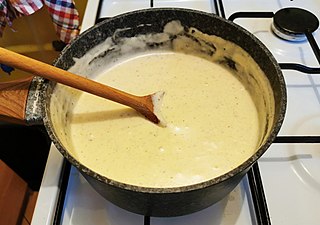
Béchamel sauce
Béchamel sauce (, French: [beʃamɛl]) is one of the mother sauces of French cuisine.
This sauce is made from a white roux (butter and flour) and milk, seasoned with ground nutmeg.

Beurre blanc
Beurre blanc ("white butter" in French) is a warm emulsified butter sauce made with a reduction of vinegar and/or white wine (normally Muscadet) and shallots into which softened whole butter is whisked in off the heat to prevent separation. The small amount of emulsifiers naturally found in butter, including a trace of lecithin, is used to form an oil-in-water emulsion. Although similar to hollandaise in concept, it is considered neither a classic leading nor compound sauce. This sauce originates in Loire Valley cuisine.

Bibimbap
Bibimbap ( BEE-bim-bap; Korean: 비빔밥; lit. mixed rice; Korean pronunciation: [pi.bim.p͈ap̚]), sometimes romanized as bi bim bap or bi bim bop, is a Korean rice dish.
The term bibim means "mixing" and bap is cooked rice. It is served as a bowl of warm white rice topped with namul (sautéed or blanched seasoned vegetables) and gochujang (chili pepper paste). Egg and sliced meat (usually beef) are common additions, stirred together thoroughly just before eating.
In South Korea, Jeonju, Jinju, and Tongyeong are especially famous for their versions of bibimbap. In 2017, the dish was listed at number 40 on the World's 50 most delicious foods readers' poll compiled by CNN Travel.

Biryani
Biryani () is a mixed rice dish most popular in South Asia. It is made with rice, some type of meat (chicken, beef, goat, lamb, prawn, or fish) and spices. To cater to vegetarians, in some cases, it is prepared by substituting vegetables for the meat. Sometimes eggs and/or potatoes are added.
Biryani is one of the most popular dishes in South Asia and among the South Asian diaspora, although the dish is often associated with the region’s Muslim population in particular. Similar dishes are also prepared in other parts of the world such as in Iraq, Myanmar, Thailand, and Malaysia. Biryani is the single most-ordered dish on Indian online food ordering and delivery services, and has been labelled as the most popular dish overall in India.

Biscotti
Biscotti (, Italian: [biˈskɔtti]; lit. 'biscuits'), known also as cantucci (Italian: [kanˈtuttʃi]), are Italian almond biscuits that originated in the Tuscan city of Prato. They are twice-baked, oblong-shaped, dry, crunchy, and may be dipped in a drink, traditionally Vin Santo.

Bisque
Bisque is a smooth, creamy, highly seasoned soup of French origin, classically based on a strained broth (coulis) of crustaceans. It can be made from lobster, langoustine, crab, shrimp, or crayfish. The French bisque is one of the most popular seafood soups around the world.
The term "bisque" is also used to refer to cream-based soups that do not contain seafood, in which the pre-cooked ingredients are pureed or processed in a food processor or a food mill. Common varieties include squash, tomato, mushroom, and red pepper.
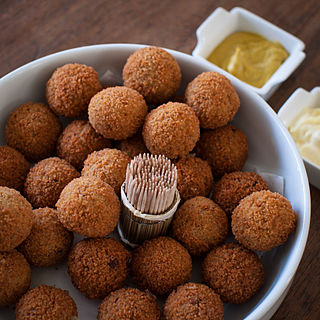
Bitterballen
Bitterballen (plural of bitterbal) are a Dutch meat-based snack, made by making a very thick stew thickened with roux and beef stock and generously loaded with meat, refrigerating the stew until it firms, and then rolling the thick mixture into balls which then get breaded and fried. Seasonings in the base stew usually include onions, salt and pepper, parsley and nutmeg. Most recipes include nutmeg and there are also variations using curry powder or that add in finely chopped vegetables such as carrot.
The bitterbal derives its name from a generic word for certain types of herb-flavoured alcoholic beverages, called a bitter in Dutch, and are popularly served as part of a bittergarnituur, a selection of savoury snacks to go with drinks, at pubs or at receptions in the Netherlands.
Bitterballen are very similar to the more common croquette (kroketten in Dutch) in ingredients and preparation/cooking methods, as well as flavour, though the larger kroketten have a distinct oblong sausage shape, but with a similar diameter.

Blini
A blini (plural blinis or blini, rarely bliny; Russian: блины pl.), singular: blin, is an Eastern European pancake made from various kinds of flour or buckwheat, wheat, etc. They may be served with smetana, tvorog, caviar and other garnishes, or simply smeared with butter. They are considered to be a traditional Russian dish. Blini are among the most popular and most-eaten dishes in Russia.
In the West, blini traditionally refers to small savory pancakes made with leavened batter. In modern Russian, the term most often refers to pan-sized leavened thin pancakes, although smaller leavened pancakes are also called blini. Smaller and thicker pancakes (with several of them baked on one larger pan) are called oladyi.
Some English dictionaries record usage of the forms blin as singular and blini or bliny as plural, which corresponds to the original Russian forms, but other dictionaries consider this usage so rare in English that they do not mention blin at all and only record the widespread modern regular usage of blini for the singular and blinis for the plural. Some cookbooks and restaurants use blin and blintchick as in Russian to refer to crêpes.
Blintzes, called blinchiki (little blinis) in Russian are an offshoot of blini. They are thin pancakes usually made of wheat flour, folded to form a casing for various kinds of filing, typically cheese, fruit, or (in Russian cuisine) pre-fried minced meat, and then sautéed or baked.

Boeuf bourguignon
Beef bourguignon (US: ) or bœuf bourguignon (UK: ; French: [bœf buʁɡiɲɔ̃]), also called beef Burgundy, and bœuf à la Bourguignonne, is a French beef stew braised in red wine, often red Burgundy, and beef stock, typically flavored with carrots, onions, garlic, and a bouquet garni, and garnished with pearl onions, mushrooms, and bacon. A similar dish using a piece of braised beef with the same garnish is pièce de bœuf à la bourguignonne.
"Bourguignon" is, since the mid-nineteenth century, a culinary term applied to various dishes prepared with wine or with a mushroom and onion garnish. It is probably not a regional recipe from Burgundy.
When made with whole roasts, the meat was often larded.

Bolognese
Bolognese sauce (UK: , US: ; known in Italian as ragù alla bolognese, Italian: [raˈɡu alla boloɲˈɲeːze, -eːse], ragù bolognese, or simply ragù) is a meat-based sauce in Italian cuisine, typical of the city of Bologna. It is customarily used to dress tagliatelle al ragù and to prepare lasagne alla bolognese.
Italian ragù alla bolognese is a slowly cooked meat-based sauce, and its preparation involves several techniques, including sweating, sautéing and braising. Ingredients include a characteristic soffritto of onion, celery and carrot, different types of minced or finely chopped beef, often alongside small amounts of fatty pork. White wine, milk, and a small amount of tomato paste or tomato sauce are added, and the dish is then gently simmered at length to produce a thick sauce.
Outside Italy, the phrase "Bolognese sauce" is often used to refer to a tomato-based sauce to which minced meat has been added; such sauces typically bear little resemblance to Italian ragù alla bolognese, being more similar in fact to ragù alla napoletana from the tomato-rich south of the country. Although in Italy ragù alla bolognese is not used with spaghetti (but rather with flat pasta, like tagliatelle), "spaghetti bolognese" has become a popular dish in many other parts of the world.
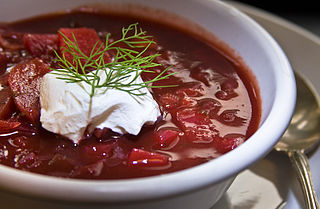
Borscht
Borscht (English: ) is a sour soup, made with meat stock, vegetables and seasonings, common in Eastern Europe and Northern Asia. In English, the word "borscht" is most often associated with the soup's variant of Ukrainian origin, made with red beetroots as one of the main ingredients, which give the dish its distinctive red color. The same name, however, is also used for a wide selection of sour-tasting soups without beetroots, such as sorrel-based green borscht, rye-based white borscht, and cabbage borscht.
Borscht derives from an ancient soup originally cooked from pickled stems, leaves and umbels of common hogweed (Heracleum sphondylium), an herbaceous plant growing in damp meadows, which lent the dish its Slavic name. With time, it evolved into a diverse array of tart soups, among which the Ukrainian beet-based red borscht has become the most popular. It is typically made by combining meat or bone stock with sautéed vegetables, which – as well as beetroots – usually include cabbage, carrots, onions, potatoes, and tomatoes. Depending on the recipe, borscht may include meat or fish, or be purely vegetarian; it may be served either hot or cold, and it may range from a hearty one-pot meal to a clear broth or a smooth drink. It is often served with smetana or sour cream, hard-boiled eggs or potatoes, but there exists an ample choice of more involved garnishes and side dishes, such as uszka or pampushky, that can be served with the soup.
Its popularity has spread throughout Eastern Europe and – by way of migration away from the Russian Empire – to other continents. In North America, borscht is often linked with either Jews or Mennonites, the groups who first brought it there from Europe. Several ethnic groups claim borscht, in its various local implementations, as their own national dish consumed as part of ritual meals within Eastern Orthodox, Greek Catholic, Roman Catholic, and Jewish religious traditions.

Bouillabaisse
Bouillabaisse (French: [bu.ja.ˈbɛs]; Occitan: bolhabaissa, bullabessa [ˌbuʎaˈβajsɔ / ˌbujaˈbajsɔ]) is a traditional Provençal fish soup originating in the port city of Marseille. The French and English form bouillabaisse comes from the Provençal Occitan word bolhabaissa, a compound that consists of the two verbs bolhir (to boil) and abaissar (to reduce heat, i.e., simmer).
Bouillabaisse was originally a dish made by Marseille fishers, using the bony rockfish which they were unable to sell to restaurants or markets. There are at least three kinds of fish in a traditional bouillabaisse, typically red rascasse (Scorpaena scrofa); sea robin; and European conger. It can also include gilt-head bream, turbot, monkfish, mullet, or European hake. It usually also includes shellfish and other seafood such as sea urchins, mussels, velvet crabs, spider crab or octopus. More expensive versions may add langoustine (Dublin Bay prawn; Norway lobster), though this was not part of the traditional dish made by Marseille fishers. Vegetables such as leeks, onions, tomatoes, celery, and potatoes are simmered together with the broth and served with the fish. The broth is traditionally served with a rouille, a mayonnaise made of olive oil, garlic, saffron, and cayenne pepper on grilled slices of bread.
What makes a bouillabaisse different from other fish soups is the selection of Provençal herbs and spices in the broth; the use of bony local Mediterranean fish; the way the fish are added one at a time, and brought to a boil; and the method of serving. In Marseille, the broth is served first in a soup plate with slices of bread and rouille, then the fish is served separately on a large platter (see image at top); or, more simply, as Julia Child suggests, the fish and broth are brought to the table separately and served together in large soup plates.

Boule
Boule, from French, meaning "ball", is a traditional shape of French bread resembling a squashed ball. A boule can be made using any type of flour and can be leavened with commercial yeast, chemical leavening, or even wild yeast (sourdough). The name of this rustic loaf shape is the reason the French call bread bakers "boulangers" and bread bakeries "boulangeries".
This bread is found especially in the regions of eastern France, such as Burgundy and Franche-Comté where a small town bears the name of Boulot.
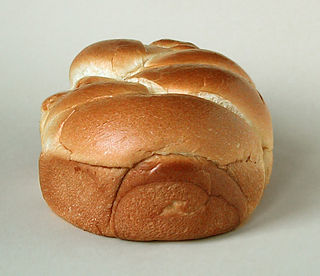
Brioche
Brioche (, also UK: , US: , French: [bʁijɔʃ]) is a bread of French origin whose high egg and butter content gives it a rich and tender crumb. The chef Joël Robuchon described it as "light and slightly puffy, more or less fine, according to the proportion of butter and eggs". It has a dark, golden, and flaky crust, frequently accentuated by an egg wash applied after proofing.
Brioche is considered a Viennoiserie because it is made in the same basic way as bread but has the richer aspect of a pastry because of the addition of eggs, butter, liquid (milk, water, cream, and, sometimes, brandy) and occasionally sugar. Brioche, along with pain au lait and pain aux raisins—which are commonly eaten at breakfast or as a snack—form a leavened subgroup of Viennoiserie. Brioche is often baked with additions of fruit or chocolate chips and served on its own or as the basis of a dessert, with many regional variations in added ingredients, fillings, or toppings.

Bruschetta
Bruschetta (, , Italian: [bruˈsketta] ) is an Italian antipasto (starter dish) consisting of grilled bread rubbed with garlic and topped with olive oil and salt. Variations may include toppings of tomato, vegetables, beans, cured meat, or cheese. In Italy, bruschetta is often prepared using a brustolina grill.

Bulgogi
Bulgogi (Korean: 불고기; American English buul-GOH-ghee; from Korean bul-gogi [pul.ɡo.ɡi]), literally "fire meat") is a gui (Korean-style grilled or roasted dish) made of thin, marinated slices of meat, most commonly beef, grilled on a barbecue or on a stove-top griddle. It is also often stir-fried in a pan in home cooking. Sirloin and rib eye are frequently used cuts of beef for the dish. The dish originated from northern areas of the Korean Peninsula, but is a very popular dish in South Korea, where it can be found anywhere from upscale restaurants to local supermarkets as pan-ready kits.

Caprese
Caprese salad (Italian: insalata caprese [insaˈlaːta kaˈpreːze; -eːse] or simply caprese) is an Italian salad, made of sliced fresh mozzarella, tomatoes, and sweet basil, seasoned with salt, and olive oil. It is usually arranged on a plate in restaurant practice. Like pizza Margherita, it features the colours of the Italian flag: green, white, and red. In Italy, it is usually served as an antipasto (starter), not a contorno (side dish), and it may be eaten any time of day. The caprese salad is one form of a caprese dish; it may also be served as a caprese pizza, pasta, or sandwich.
The salad is named after the island of Capri, where it is believed to have originated. Two common stories about its origin include it being an homage to the Italian flag or "in the 20th century to appease the palates of vacationing royalty and important politicos".

Carbonara
Carbonara (Italian: [karboˈnaːra]) is a pasta dish made with eggs, hard cheese, fatty cured pork, and black pepper. The dish took its modern form and name in the middle of the 20th century.
The cheese is usually pecorino romano. Some variations use Parmesan, Grana Padano, or a combination of cheeses. Spaghetti is the most common pasta, but rigatoni or bucatini are also used. While guanciale, a cured pork jowl, is traditional, some variations use pancetta, and lardons of smoked bacon are a common substitute outside Italy.

Carpaccio
Carpaccio (UK: , US: , Italian: [karˈpattʃo]) is a dish of meat or fish (such as beef, veal, venison, salmon or tuna), thinly sliced or pounded thin, and served raw, typically as an appetizer. It was invented in 1963 by Giuseppe Cipriani from Harry's Bar in Venice, Italy, and popularised during the second half of the twentieth century. The beef was served with lemon, olive oil, and white truffle or Parmesan cheese. Later, the term was extended to dishes containing other raw meats or fish, thinly sliced and served with lemon or vinegar, olive oil, salt and ground pepper, and fruits such as mango or pineapple.
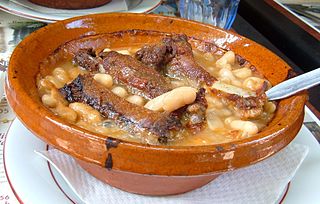
Cassoulet
Cassoulet (, also UK: ,US: ; French: [kasulɛ]) is a rich, slow-cooked stew originating in southern France. The food writer Elizabeth David described it as "that sumptuous amalgamation of haricot beans, sausage, pork, mutton and preserved goose, aromatically spiced with garlic and herbs". It originated in the town of Castelnaudary in the Aude department in the Occitanie region. Variants of the dish are local to other towns and cities in the Aude.

Ceviche
Ceviche, cebiche, sebiche, or seviche (Spanish pronunciation: [seˈβitʃe]) is a dish consisting of fish or shellfish marinated in citrus and seasonings, recognized by UNESCO as an expression of Peruvian traditional cuisine and Intangible Cultural Heritage of Humanity, although different versions of ceviche are part of the culinary culture of various Spanish-American countries along the Pacific Ocean where each one is native: Chile, Colombia, Costa Rica, Ecuador, El Salvador, Guatemala, Honduras, Mexico, Nicaragua, Panama and Peru. In Peru it is also considered a flagship dish and cultural heritage.
The fish is typically cured in lemon or sour lime juice, although sour orange was historically used. The dressing also includes some local variety of chili pepper or chili, replaced by mustard in some locations in Central America. The meat is usually marinated together with sliced or chopped onion and served with chopped cilantro. In Mexico tomato and avocado are also usually included, and the addition of tomato sauce is common except in Chile, Panama and Peru.
The ceviche accompaniments can also be different: in Ecuador, with plantain, canguil or chifles patacones, and in Colombia, Panama and Guatemala, with salty soda crackers. The northern varieties usually use cookies or toast as a garnish. In Mexico, it is served with corn tostadas or with crackers; in Panama an extra option is the spicy chombo chili pepper to taste, and in Peru it is served with garnishes of boiled root vegetables such as sweet potatoes, cassava or, very rarely, potatoes, and grains or seeds such as corn (boiled or roasted), legumes such as zarandaja, fried plantain (chifles), seaweed and lettuce; sometimes it can be accompanied by chilcano (broth made from fish heads).

Channa masala
Chana masala (also chole masala, or chole) is a chickpea curry originating in the Indian subcontinent. It is a staple dish in North Indian cuisine.

Chapati
Chapati (alternatively spelled chapathi; pronounced as IAST: capātī, capāṭī, cāpāṭi), also known as roti, rooti, rotee rotli, rotta, safati, shabaati, phulka (in Marathi), chapo (in East Africa), sada roti (in the Caribbean), poli, and roshi (in the Maldives), is an unleavened flatbread originating from the Indian subcontinent and is a staple in India, Nepal, Bangladesh, Pakistan, Sri Lanka, the Arabian Peninsula, East Africa, and the Caribbean. Chapatis are made of whole-wheat flour known as atta, mixed into dough with water, oil (optional), and salt (optional) in a mixing utensil called a parat, and are cooked on a tava (flat skillet).
It is a common staple in the Indian subcontinent as well as amongst expatriates from the Indian subcontinent throughout the world. Chapatis were also introduced to other parts of the world by immigrants from the Indian subcontinent, particularly by Indian merchants to Central Asia, Southeast Asia, East Africa, and the Caribbean.

Char siu
Char siu (Chinese: 叉燒; Cantonese Yale: chāsīu) is a Cantonese-style of barbecued pork. Originating in Guangdong, it is eaten with rice, used as an ingredient for noodle dishes or in stir fries, and as a filling for chasiu baau or pineapple buns. Five-spice powder is the primary spice, honey or other sweeteners are used as a glaze, and the characteristic red color comes from the red yeast rice when made traditionally.
It is classified as a type of siu mei (燒味), Cantonese roasted meat.
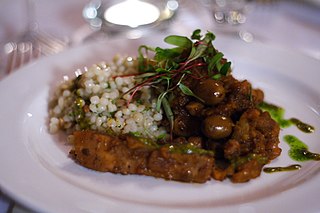
Charmoula
Chermoula (Berber: tacermult or tacermilt, Arabic: شرمولة) or charmoula is a marinade and relish used in Algerian, Libyan, Moroccan and Tunisian cooking. It is traditionally used to flavor fish or seafood, but it can be used on other meats or vegetables. It is somewhat similar to the Latin American chimichurri.

Chimichurri
Chimichurri (Spanish: [tʃimiˈtʃuri]) is an uncooked sauce used as an ingredient in cooking and as a table condiment for grilled meat. Found originally in Argentinian and Uruguayan cuisines, it has become widely adopted in most of Latin America. The sauce comes in green (chimichurri verde) and red (chimichurri rojo) varieties. It is made of finely chopped flat leaf parsley, red pepper flakes, minced garlic, olive oil, oregano and vinegar or lemon juice. It is similar to Moroccan chermoula.

Chow mein
Chow mein ( and , simplified Chinese: 炒面; traditional Chinese: 炒麵; Pinyin: chǎomiàn) is a Chinese dish made from stir-fried noodles with vegetables and sometimes meat or tofu. Over the centuries, variations of chǎomiàn were developed in many regions of China; there are several methods of frying the noodles and a range of toppings can be used. It was introduced in other countries by Chinese immigrants. The dish is popular throughout the Chinese diaspora and appears on the menus of most Chinese restaurants abroad. It is particularly popular in India, Nepal, the UK, and the US.

Chutney
A chutney (Bengali: চাটনি romanised: chatni Hindi: चटनी romanised: chatnee Urdu: چٹنی romanised: chatnee Bhojpuri: चटनी) is a spread typically associated with cuisines of the Indian subcontinent. Chutneys are made in a wide variety of forms, such as a tomato relish, a ground peanut garnish, yogurt or curd, cucumber, spicy coconut, spicy onion or mint dipping sauce.
A common variant in Anglo-Indian cuisine uses a tart fruit such as sharp apples, rhubarb or damson pickle made milder by an equal weight of sugar (usually demerara, turbinado or brown sugar to replace jaggery in some Indian sweet chutneys). Vinegar was added to the recipe for English-style chutney that traditionally aims to give a long shelf life so that autumn fruit can be preserved for use throughout the year (as are jams, jellies and pickles) or to be sold as a commercial product. Indian pickles use mustard oil as a pickling agent, but Anglo-Indian style chutney uses malt or cider vinegar which produces a milder product. In Western cuisine, chutney is often eaten with hard cheese or with cold meats and fowl, typically in cold pub lunches.
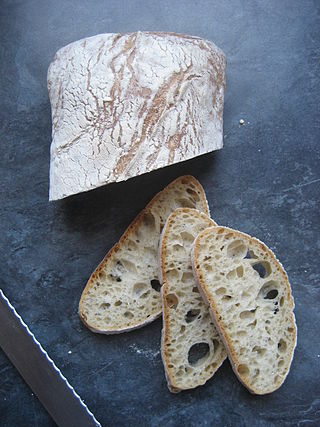
Ciabatta
Ciabatta (, Italian: [tʃaˈbatta]; lit. 'slipper') is an Italian white bread made from wheat flour, water, salt, yeast and olive oil, created in 1982 by a baker in Adria, province of Rovigo, Veneto, Italy, in response to the popularity of French baguettes. Ciabatta is somewhat elongated, broad, and flat, and is baked in many variations, although unique for its alveolar holes. Ciabatta is made with a strong flour and uses a very high hydration dough.
While panino indicates any kind of sandwich regardless of the bread used (whether slices or a bun), toasted sandwiches made from small loaves of ciabatta are known as panini (plural of panino) outside Italy.

Consommé
In cooking, a consommé is a type of clear soup made from richly flavoured stock or broth that has been clarified, a process that uses egg whites to remove fat and sediment.
Consommé has three English pronunciations: traditionally in the UK, the stress is on the middle syllable; in modern UK English, the stress is on the first; and in the US the stress is on the last.

Coq au vin
Coq au vin (; French: [kɔk o vɛ̃], "rooster/cock with wine") is a French dish of chicken braised with wine, lardons, mushrooms, and optionally garlic. A red Burgundy wine is typically used, though many regions of France make variants using local wines, such as coq au vin jaune (Jura), coq au riesling (Alsace), coq au pourpre or coq au violet (Beaujolais nouveau), and coq au Champagne.

Coulis
A coulis ( koo-LEE) is a form of thin sauce made from puréed and strained vegetables or fruits. A vegetable coulis is commonly used on meat and vegetable dishes, and it can also be used as a base for soups or other sauces. Fruit coulis are most often used on desserts. Raspberry coulis, for example, is especially popular with poached apples or Key lime pie. Tomato coulis may be add flavor to other sauces, or on its own (either cold or hot).
The term comes from Old French coleïs, meaning flowing or running.
The way of making coulis varies with the type of fruit or vegetable used: it is possible to simply mash raspberries and strawberries through a strainer with a spoon, while ripe pears and melons are usually pureed in a blender prior to straining, apples have to be cooked first. Depending on the consistency of the puree, either a chinois (for the softest purees), food mill, or drum sieve (for the hardest ones) can be used for straining. Reduction of coulis (to strengthen its sweetness and flavor) can be difficult as the sauce may acquire a jam-like taste when heated, so sometimes the vacuum evaporation is used to boil the mixture at a lower temperature.

Crème brûlée
Crème brûlée or crème brulée (; French pronunciation: [kʁɛm bʁy.le]), also known as burnt cream or Trinity cream, and virtually identical to crema catalana, is a dessert consisting of a rich custard base topped with a layer of hardened caramelized sugar. It is normally served slightly chilled; the heat from the caramelizing process tends to warm the top of the custard, while leaving the center cool. The custard base is traditionally flavored with vanilla in French cuisine, but can have other flavorings. It is sometimes garnished with fruit.

Crêpe
A crêpe or crepe ( or , French: [kʁɛp] , Quebec French: [kʁaɪ̯p] ) is a very thin type of pancake. Crêpes are usually one of two varieties: sweet crêpes (crêpes sucrées) or savoury galettes (crêpes salées). They are often served with a wide variety of fillings such as cheese, fruit, vegetables, meats, and a variety of spreads. Crêpes can also be flambéed, such as in crêpes Suzette.

Crostini
Crostini (meaning 'little crusts' in Italian; SG: crostino) are an Italian appetizer consisting of small slices of grilled or toasted bread and toppings. The toppings may include a variety of different cheeses, meats, vegetables and condiments, or may be presented more simply with a brush of olive oil and herbs or a sauce.
Along with bruschetta, crostini are thought to originate in medieval times when it was typical for peasants to eat their meals on slices of bread instead of using ceramics.
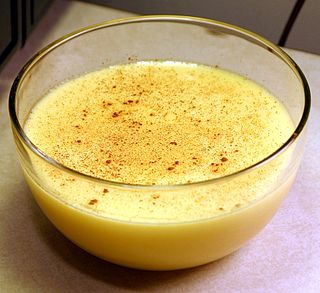
Custard
Custard is a variety of culinary preparations based on sweetened milk, cheese, or cream cooked with egg or egg yolk to thicken it, and sometimes also flour, corn starch, or gelatin. Depending on the recipe, custard may vary in consistency from a thin pouring sauce (crème anglaise) to the thick pastry cream (crème pâtissière) used to fill éclairs. The most common custards are used in custard desserts or dessert sauces and typically include sugar and vanilla; however, savory custards are also found, e.g., in quiche.

Demi glace
Demi-glace (French pronunciation: [dəmi ɡlas], 'half glaze') is a rich brown sauce in French cuisine used by itself or as a base for other sauces. The term comes from the French word glace, which, when used in reference to a sauce, means "icing" or "glaze." It is traditionally made by combining one part espagnole sauce and one part brown stock. The sauce is then reduced by half, strained of any leftover impurities, and finished with a sherry wine.
Common variants of demi-glace use a 1:1 mixture of beef or chicken stock to sauce espagnole; these are referred to as "beef demi-glace" (demi-glace au bœuf) or "chicken demi-glace" (demi-glace au poulet). The term "demi-glace" by itself implies that it is made with the traditional veal stock.

Empanada
An empanada is a type of baked or fried turnover consisting of pastry and filling, common in Spain, other Southern European countries, Latin American countries, and the Philippines. The name comes from the Spanish empanar (to bread, i.e., to coat with bread), and translates as 'breaded', that is, wrapped or coated in bread. They are made by folding dough over a filling, which may consist of meat, cheese, tomato, corn, or other ingredients, and then cooking the resulting turnover, either by baking or frying.

Escargots
Snails are considered edible in many areas such as the Mediterranean region, Africa, France and Southeast Asia, while in other cultures, snails are seen as a taboo food. In American English, edible land snails are also called escargot, taken from the French word for "snail", and the production of snails for consumption is called snail farming or heliciculture. Snails as a food date back to ancient times, with numerous cultures worldwide having traditions and practices that attest to their consumption.
The snails are collected after the rains and are put to "purge" (fasting). In the past, the consumption of snails had a marked seasonality, from April to June. However, thanks to snail breeding techniques, today they are available all year round. Heliciculture occurs mainly in Spain, France, and Italy, which are also the countries with the greatest culinary tradition of the snail. Although throughout history the snail has had little value in the kitchen because it is considered "poverty food", in recent times it can be classified as a delicacy thanks to the appreciation given to it by haute cuisine chefs.
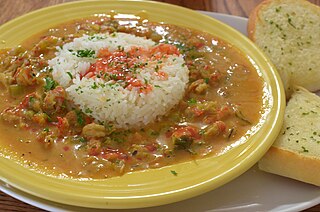
Étouffée
Étouffée or etouffee (French: [e.tu.fe], English: AY-too-FAY) is a dish found in both Cajun and Creole cuisine typically served with shellfish over rice. The dish employs a technique known as smothering, a popular method of cooking in the Cajun and Creole areas of southwest Louisiana. Étouffée is most popular in New Orleans and in the Acadiana region of the southernmost half of Louisiana as well as the coastal counties of Mississippi, Alabama, northern Florida, and eastern Texas.

Falafel
Falafel (; Arabic: فلافل, [fæˈlæːfɪl] ) is a deep-fried ball or patty-shaped fritter of Egyptian origin, featuring in Middle Eastern cuisine, particularly Levantine cuisines, and is made from broad beans, ground chickpeas, or both.
Falafel is often served in a pita, samoon, laffa, or wrapped in a flatbread known as taboon; "falafel" also frequently refers to a wrapped sandwich that is prepared in this way. The falafel balls may be topped with salads, pickled vegetables, and hot sauce, and drizzled with tahini-based sauces. Falafel balls may also be eaten alone as a snack or served as part of a meze tray (assortment of appetizers).
Falafel is eaten throughout the Middle East and is a common street food. Falafel is usually made with fava beans in Egyptian cuisine, with chickpeas in Palestinian cuisine, or either just chickpeas or a combination of both in Jordan, Lebanon and Syria. It is popular with vegetarians worldwide. The Palestinian chickpea version of the falafel has been adopted into Israeli cuisine, where it features prominently and has been called a national dish of Israel, which Palestinians and other Arabs have criticized and characterized as cultural appropriation.

Feijoada
Feijoada (Portuguese pronunciation: [fejʒuˈadɐ]) is a stew of beans with beef and pork. The name feijoada is derived from feijão, 'bean' in Portuguese. It is widely prepared in the Portuguese-speaking world, with slight variations. The basic ingredients of feijoada are beans and fresh pork or beef.
Feijoada is a common name given to dishes from Portuguese-speaking countries such as Portugal, Brazil, Angola, Mozambique, and Macau, where it is made from a mixture of meat and white, black or red beans, usually accompanied by rice.
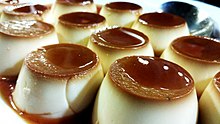
Flan
Crème caramel (French: [kʁɛm kaʁamɛl]), flan, caramel pudding, condensed milk pudding or caramel custard is a custard dessert with a layer of clear caramel sauce.

Focaccia
Focaccia (UK: fə-KATCH-ə, US: foh-KAH-ch(ee-)ə, Italian: [foˈkattʃa]; Ligurian: fugassa, Ligurian: [fyˈɡasːa]; Barese: fecazze, Neapolitan: [fəˈkattsə]) is a flat leavened oven-baked Italian bread. In some contemporary places, such as Rome, it is a style of pizza, also called pizza bianca (lit. 'white pizza'). Focaccia may be served as a side dish or as sandwich bread and it may be round, rectangular, or square shape.

Fondue
Fondue (UK: , US: , French: [fɔ̃dy]) is a Swiss melted cheese and wine dish served in a communal pot (caquelon or fondue pot) over a portable stove (réchaud) heated with a candle or spirit lamp, and eaten by dipping bread and sometimes vegetables into the cheese using long-stemmed forks. It was promoted as a Swiss national dish by the Swiss Cheese Union (Schweizerische Käseunion) in the 1930s, and was popularized in North America in the 1960s.
Since the 1950s, the term "fondue" has been generalized to other dishes in which a food is dipped into a communal pot of liquid kept hot in a fondue pot: chocolate fondue, fondue au chocolat, in which pieces of fruit or pastry are dipped into a melted chocolate mixture, and fondue bourguignonne, in which pieces of meat are cooked in hot oil or broth.

Ganache
Ganache ( or ; French: [ɡanaʃ]) is a glaze, icing, sauce, or filling for pastries, made from chocolate and cream.

Gastrique
Gastrique is caramelized sugar, deglazed with vinegar or other sour liquids, used as a sweet and sour flavoring for sauces.
The gastrique is generally added to a fond, reduced stock or brown sauce. It is also used to flavor sauces such as tomato sauce, savory fruit sauces, and others, such as the orange sauce for duck à l'orange.
The term is often broadened to mean any sweet and sour sauce, e.g., citrus gastrique or mango gastrique. An agrodolce is a similar sauce found in Italian cuisine.
It is different from the Belgian sauce base of the same name, which consists of vinegar, white wine, shallots, tarragon stems, bouquet garni, and peppercorns. The gastrique with this composition was already used by Auguste Escoffier, but at the end of the 19th century, Louis Védy from Brussels turned it into a plant extract that ensures a constant level of acidity when making béarnaise sauce.

Gazpacho
Gazpacho (Spanish: [ɡaθˈpatʃo]) or gaspacho (Portuguese: [ɡɐʃˈpaʃu]), also called Andalusian gazpacho, is a cold soup and drink made of raw, blended vegetables. It originated in the southern regions of the Iberian peninsula and spread into other areas. Gazpacho is widely eaten in Spain and Portugal, particularly during hot summers, since it is refreshing and cool.
Although there are other recipes called gazpacho, such as gazpacho manchego, the standard usage implies a soup. There are also a number of dishes that are closely related and often considered variants thereof, such as ajoblanco, salmorejo, pipirrana, porra antequerana (closer to a bread soup), and cojondongo.

Gnocchi
Gnocchi ( N(Y)OK-ee, US also N(Y)OH-kee, N(Y)AW-; Italian: [ˈɲɔkki]; SG: gnocco) are a varied family of dumpling in Italian cuisine. They are made of small lumps of dough, such as those composed of a simple combination of wheat flour, potato, egg, and salt. Variations of the dish supplement the simple recipe with flavour additives, such as semolina flour, cheese, breadcrumbs, cornmeal or similar ingredients, and possibly including herbs, vegetables, and other ingredients. Base ingredients may be substituted with alternatives such as sweet potatoes for potatoes or rice flour for wheat flour. Such variations are often considered to be non-traditional.
Gnocchi are commonly cooked in salted boiling water and then dressed with various sauces. They are usually eaten as a first course (primo piatto) as an alternative to soups (minestre) or pasta, but they can also be served as a contorno (side dish) to some main courses. Common accompaniments of gnocchi include melted butter with sage, pesto, as well as various sauces. Gnocchi may be homemade, made by specialty stores, or produced industrially and distributed refrigerated, dried, or frozen. Most gnocchi are boiled in water and then served with a sauce. Small soup gnocchi are sometimes made by pressing the dough through a coarse sieve or a perforated spoon.

Goulash
Goulash (Hungarian: gulyás) is a soup or stew of meat and vegetables seasoned with paprika and other spices. Originating in Hungary, goulash is a common meal predominantly eaten in Central Europe but also in other parts of Europe. It is one of the national dishes of Hungary and a symbol of the country.
Its origin may be traced back as far as the 10th century, to stews eaten by Hungarian shepherds. At that time, the cooked and flavored meat was dried with the help of the sun and packed into bags produced from sheep's stomachs, needing only water to make it into a meal. Earlier versions of goulash did not include paprika, as it was not introduced to Europe until the 16th century.

Gratin
Gratin (French: [ɡʁatɛ̃]) is a culinary technique in which an ingredient is topped with a browned crust, often using breadcrumbs, grated cheese, egg or butter. The term may be applied to any dish made using this method. Gratin is usually prepared in a shallow dish of some kind. A gratin is baked or cooked under an overhead grill or broiler to form a golden crust on top and is often served in its baking dish.
A gratin dish is a shallow oven-proof container used to prepare gratins and similar dishes.

Gremolata
Gremolata (Italian: [ɡremoˈlaːta]) or gremolada (Italian: [ɡremoˈlaːda], Lombard: [ɡremuˈlaːda]) is a green sauce made of chopped parsley, lemon zest, and garlic. It is the standard accompaniment to the Milanese braised veal shank dish ossobuco alla milanese.

Guacamole
Guacamole (Spanish: [ɡwakaˈmole] ; informally shortened to guac in the United States since the 1980s) is an avocado-based dip, spread, or salad first developed in Mexico. In addition to its use in modern Mexican cuisine, it has become part of international cuisine as a dip, condiment and salad ingredient.

Gyoza
Jiaozi (Chinese: 餃子; [tɕjàʊ.tsɨ] ) are a type of Chinese dumpling. Jiaozi typically consist of a ground meat and/or vegetable filling wrapped into a thinly rolled piece of dough, which is then sealed by pressing the edges together. Finished jiaozi can be boiled (shuǐ jiǎo), steamed (zhēng jiǎo), pan fried (jiān jiǎo), or deep fried (zhá jiǎo), and are traditionally served with a black vinegar and sesame oil dip. They can also be served in a soup (tāng jiǎo).
Jiaozi have great cultural significance attached to them within China. Jiaozi are one of the major dishes eaten during the Chinese New Year throughout northern China and eaten all year round in the northern provinces. Their resemblance to the gold and silver ingots (sycee) used in Imperial China has meant that they symbolize wealth and good fortune. Though considered part of Chinese cuisine, jiaozi are also popular in other parts of East Asia, where a Japanese variety is referred to as gyoza, and in the Western world, where a fried variety is referred to as potstickers. The English-language term "potsticker" was invented by Buwei Yang Chao in her book How to Cook and Eat in Chinese (1945).

Gyro
Gyros, sometimes anglicized as a gyro (; Greek: γύρος, romanized: yíros/gyros, lit. 'turn', pronounced [ˈʝiros]) in some regions, is meat cooked on a vertical rotisserie, then sliced and served wrapped or stuffed in pita bread, along with other ingredients such as tomato, onion, fried potatoes, and tzatziki. In Greece, it is normally made with pork or sometimes with chicken, whilst beef and lamb are also used in other countries.
Gyros is made in a similar manner to other dishes such as the Arab shawarma, Canadian donair, Mexican al pastor, and the Turkish Döner kebab.

Hollandaise
Hollandaise sauce ( or ; French: [ɔlɑ̃dɛz]), meaning Dutch sauce in French, is a mixture of egg yolk, melted butter, and lemon juice (or a white wine or vinegar reduction). It is usually seasoned with salt, and either white pepper or cayenne pepper.
It is well known as a key ingredient of eggs Benedict, and is often served on vegetables such as steamed asparagus.

Hummus
Hummus (, ; Arabic: حُمُّص ḥummuṣ, "chickpeas"), also spelled hommus or houmous, is a Middle Eastern dip, spread, or savory dish made from cooked, mashed chickpeas blended with tahini, lemon juice, and garlic. The standard garnish in the Middle East includes olive oil, a few whole chickpeas, parsley, and paprika.
The earliest mention of Hummus comes from Syria, in a 13th-century cookbook attributed to the Aleppine historian Ibn al-Adim.
Popular in Middle Eastern cuisine, it is usually eaten as a dip, with pita bread. In the West, it is now produced industrially, and is often served as a snack or appetizer with crackers or vegetables.

Injera
Injera (Amharic: እንጀራ, romanized: ənǧära, [ɨndʒəra]; Oromo: Biddeena; Tigrinya: እንጀራ and ጣይታ, romanized: ənǧära and ṭayta) is a sour fermented pancake-like flatbread with a slightly spongy texture, traditionally made of teff flour. In Ethiopia, Eritrea, and some parts of Sudan and Kenya, injera is a staple. Injera is central to the dining process, like bread or rice elsewhere and is usually stored in the mesob.

Kimchi
Kimchi (; Korean: 김치, romanized: gimchi, IPA: [kim.tɕʰi]) is a traditional Korean banchan consisting of salted and fermented vegetables, most commonly using napa cabbage or Korean radish. A wide selection of seasonings are used, including gochugaru (Korean chili powder), spring onions, garlic, ginger, and jeotgal (salted seafood), etc. Kimchi is also used in a variety of soups and stews. Kimchi is a staple food in Korean cuisine and is eaten as a side dish with almost every Korean meal.
There are hundreds of different types of kimchi made with different vegetables as the main ingredients. Traditionally, winter kimchi, called kimjang, was stored in large earthenware fermentation vessels, called onggi, in the ground to prevent freezing during the winter months and to keep it cool enough to slow down the fermentation process during summer months. The vessels are also kept outdoors in special terraces called jangdokdae. In contemporary times, household kimchi refrigerators are more commonly used.

Marzipan
Marzipan is a confection consisting primarily of sugar, honey, and almond meal (ground almonds), sometimes augmented with almond oil or extract.
It is often made into sweets; common uses are chocolate-covered marzipan and small marzipan imitations of fruits and vegetables. It can also be used in biscuits or rolled into thin sheets and glazed for icing cakes, primarily birthday cakes, wedding cakes and Christmas cakes. Marzipan may also be used as a baking ingredient, as in stollen or banket. In some countries, it is shaped into small figures of animals as a traditional treat for New Year's Day or Christmas. Marzipan is also used in Tortell, and in some versions of king cake eaten during the Carnival season.

Meringue
Meringue ( mə-RANG, French: [məʁɛ̃ɡ] ) is a type of dessert or candy, of French origin, traditionally made from whipped egg whites and sugar, and occasionally an acidic ingredient such as lemon, vinegar, or cream of tartar. A binding agent such as salt, flour or gelatin may also be added to the eggs. The key to the formation of a good meringue is the formation of stiff peaks by denaturing the protein ovalbumin (a protein in the egg whites) via mechanical shear.
They are light, airy and sweet confections. Homemade meringues are often chewy and soft with a crisp exterior, while many commercial meringues are crisp throughout. A uniform crisp texture may be achieved at home by baking at a low temperature (80–90 °C or 176–194 °F) for an extended period of up to two hours.

Minestrone
Minestrone (, Italian: [mineˈstroːne]) is a thick soup of Italian origin made with meats, vegetables, and pasta. Ingredients include beans, onions, celery, carrots, leaf vegetables, stock, parmesan cheese and tomatoes.
There is no set recipe for minestrone, since it can usually be made out of whatever meat and vegetables are at one's disposal. It contains animal bone-based stock (such as chicken stock). Food author Angelo Pellegrini claimed that the base of minestrone is bean broth, and that borlotti beans (also called Roman beans) "are the beans to use for genuine minestrone".

Mole
Mole, pronounced [ˈmole], from Nahuatl mōlli (Nahuatl pronunciation: [ˈmoːlːi]) meaning "sauce", is a traditional sauce and marinade originally used in Mexican cuisine. In contemporary Mexico the term is used for a number of sauces, some quite dissimilar, including mole amarillo or amarillito (yellow mole), mole chichilo, mole colorado or coloradito (reddish mole), mole manchamantel or manchamanteles (tablecloth stainer), mole negro (black mole), mole rojo (red mole), mole verde (green mole), mole poblano, mole almendrado (mole with almond), mole michoacano, mole prieto, mole ranchero, mole tamaulipeco, mole xiqueno, mole pipián (mole with squash seed), mole rosa (pink mole), mole blanco (white mole), chimole, guacamole (mole with avocado) and huaxmole (mole with huaje).
Generally, a mole sauce contains fruits, nuts, chili peppers, and spices like black pepper, cinnamon, or cumin.
While not moles in the classic sense, there are some dishes that use the term in their name. Mole de olla is a stew made from beef and vegetables, which contains guajillo and ancho chili, as well as a number of other ingredients found in moles.

Muffaletta
The muffuletta or muffaletta is a type of round Sicilian sesame bread and a popular sandwich that originated among Italian immigrants in New Orleans, Louisiana, using the same bread.

Naan
Naan is a leavened, oven-baked (usually using a tandoor) or tawa-fried flatbread, which is found in the cuisines mainly of Iran, Afghanistan, Central Asia, the Indian subcontinent, Indonesia, Malaysia, Myanmar, and the Caribbean.

Nigiri
Sushi (すし, 寿司, 鮨, 鮓, pronounced [sɯɕiꜜ] or [sɯꜜɕi] ) is a Japanese dish of prepared vinegared rice (鮨飯, sushi-meshi), usually with some sugar and salt, plus a variety of ingredients (ねた, neta), such as vegetables, and any meat, but most commonly seafood (often raw but can be cooked). Styles of sushi and its presentation vary widely, but the one key ingredient is "sushi rice", also referred to as shari (しゃり), or sumeshi (酢飯).
The creator of modern sushi is believed to be Hanaya Yohei, who invented nigiri-zushi, a type of sushi most known today, in which seafood is placed on hand-pressed vinegared rice, around 1824 in the Edo period (1603–1867). It was the fast food of the chōnin class in the Edo period.
Sushi is traditionally made with medium-grain white rice, though it can be prepared with brown rice or short-grain rice. It is very often prepared with seafood, such as squid, eel, yellowtail, salmon, tuna or imitation crab meat. Many types of sushi are vegetarian. It is often served with pickled ginger (gari), wasabi, and soy sauce. Daikon radish or pickled daikon (takuan) are popular garnishes for the dish.
Sushi is sometimes confused with sashimi, a dish that consists of thinly sliced raw fish or occasionally meat, without sushi rice.

Osso Buco
Ossobuco or osso buco (pronounced [ˌɔssoˈbuːko]; Milanese: òss bus [ˌɔz ˈbyːs]) is a specialty of Lombard cuisine of cross-cut veal shanks braised with vegetables, white wine, and broth. It is often garnished with gremolata and traditionally served with either risotto alla milanese or polenta, depending on the regional variation. The marrow in the hole in the bone, a prized delicacy, is the defining feature of the dish.
The two types of ossobuco are a modern version that has tomatoes and the original version which does not. The older version, ossobuco in bianco, is flavoured with cinnamon, bay leaf, and gremolata. The modern and more popular recipe includes tomatoes, carrots, celery, and onions; gremolata is optional. While veal is the traditional meat used for ossobuco, dishes with other meats such as pork have been called ossobuco.

Pad thai
Pad thai, phat thai, or phad thai ( or ; Thai: ผัดไทย, RTGS: phat thai, ISO: p̄hạd thịy, pronounced [pʰàt̚ tʰāj] , 'Thai stir fry'), is a stir-fried rice noodle dish commonly served as a street food in Thailand as part of the country's cuisine. It is typically made with rice noodles, shrimp, peanuts, a scrambled egg, and bean sprouts. The ingredients are fried in a wok.
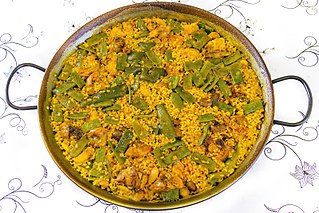
Paella
Paella (, , py-EL-ə, pah-AY-yə, Valencian: [paˈeʎa], Spanish: [paˈeʝa]) is a rice dish originally from the Valencian Community. Paella is regarded as one of the community's identifying symbols. It is one of the best-known dishes in Spanish cuisine.
The dish takes its name from the wide, shallow traditional pan used to cook the dish on an open fire, paella being the word for a frying pan in Valencian/Catalan language. As a dish, it may have ancient roots, but in its modern form, it is traced back to the mid-19th century, in the rural area around the Albufera lagoon adjacent to the city of Valencia, on the Mediterranean coast of Spain.
Paella valenciana is the traditional paella of the Valencia region, believed to be the original recipe, and consists of round-grain rice, bajoqueta and tavella (varieties of green beans), rabbit, chicken, sometimes duck, and garrofó (a variety of lima or butter bean), cooked in olive oil and chicken broth. The dish is sometimes seasoned with whole rosemary branches. Traditionally, the yellow color comes from saffron, but turmeric and Calendula can be used as substitutes. Artichoke hearts and stems may be used as seasonal ingredients. Most paella cooks use bomba rice, but a cultivar known as senia is also used in the Valencia region.
Paella de marisco (seafood paella) replaces meat with seafood and omits beans and green vegetables, while paella mixta (mixed paella) combines meat from livestock, seafood, vegetables, and sometimes beans, with the traditional rice.
Other popular local variations of paella are cooked throughout the Mediterranean area, the rest of Spain, and internationally.

Panini
A panino (Italian: [paˈniːno], meaning 'small bread', 'bread roll') or panini (pl.) is a sandwich made with Italian bread (such as ciabatta and michetta), usually served warm after grilling or toasting.
In many English-speaking countries, the name panini is given to a grilled sandwich made using various breads, including baguette, ciabatta, focaccia, and michetta. The bread is cut horizontally and filled with deli ingredients such as cheese, ham, mortadella, salami, or other food, and often served warm after having been pressed by a warming grill.

Panna cotta
Panna cotta (lit. 'cooked cream') is an Italian dessert of sweetened cream thickened with gelatin and molded. The cream may be aromatized with coffee, vanilla, or other flavorings.
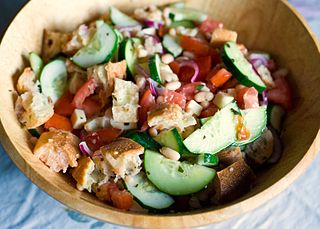
Panzanella
Panzanella [pantsaˈnɛlla] or panmolle [pamˈmɔlle] is a Tuscan and Umbrian chopped salad of soaked stale bread, onions and tomatoes that is popular in the summer. It often includes cucumbers, sometimes basil and is dressed with olive oil and vinegar.
It is also popular in other parts of central Italy.

Paratha
Paratha (pronounced [pəˈɾɑːtʰɑː]) is a flatbread native to the Indian subcontinent, with earliest reference mentioned in early medieval Sanskrit text from Karnataka, India; prevalent throughout the modern-day nations of India, Sri Lanka, Pakistan, Nepal, Bangladesh, Maldives, Afghanistan, Myanmar, Malaysia, Singapore, Thailand, Mauritius, Fiji, Guyana, Suriname, and Trinidad and Tobago where wheat is the traditional staple. It is one of the most popular flatbreads in the Indian subcontinent and the Middle East. Paratha is an amalgamation of the words parat and atta, which literally means layers of cooked dough. Alternative spellings and names include parantha, parauntha, prontha, parontay, paronthi (Punjabi), porota (in Bengali), paratha (in Odia,Urdu, Hindi), palata (pronounced [pəlàtà]; in Myanmar), porotha (in Assamese), forota (in Sylheti), farata (in Mauritius and the Maldives), prata (in Southeast Asia), paratha, buss-up shut, oil roti (in the Anglophone Caribbean) and roti canai in Malaysia and Indonesia.
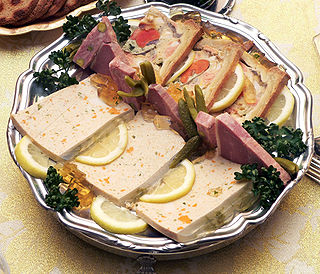
Pâté
Pâté (UK: PAT-ay, US: pa(h)-TAY, French: [pɑte] ) is a forcemeat, sometimes enclosed in a crust. Common forcemeats include ground meat from pork, poultry, fish or beef; fat, vegetables, herbs, spices and either wine or brandy (often cognac or armagnac).
It is typically served as an appetizer, on or with bread or crackers. Pâté can be served either hot or cold, but it is considered to develop its best flavors after a few days of chilling.
Canned pâté, being shelf-stable, is commonly found in military rations, especially French military rations, which have included canned pâté for over 100 years.

Pesto
Pesto (Italian: [ˈpesto]) is a paste that traditionally consists of crushed garlic, European pine nuts, coarse salt, basil leaves, and hard cheese such as Parmesan or pecorino sardo (cheese made from sheep's milk), all blended with olive oil. It originated in Genoa, the capital city of Liguria, Italy.

Pho
Pho (UK: , US: FUH, Canada: FAW; Vietnamese: [fəː˧˩˧] ) is a Vietnamese soup dish consisting of broth, rice noodles (bánh phở), herbs, and meat (usually beef (phở bò), sometimes chicken (phở gà)). Phở is a popular food in Vietnam where it is served in households, street-stalls, and restaurants country-wide. Residents of the city of Nam Định were the first to create Vietnamese traditional phở. It is considered Vietnam's national dish.
Phở originated in the early 20th century in Northern Vietnam, and after the Vietnam War, refugees popularized it throughout the world. Because phở's origins are poorly documented, there is disagreement over the cultural influences that led to its development in Vietnam, as well as the etymology of the name. The Hanoi (northern) and Saigon (southern) styles of pho differ by noodle width, sweetness of broth, and choice of herbs and sauce.

Pico de gallo
Pico de gallo (Spanish pronunciation: [ˈpiko ðe ˈɣaʝo], lit. 'rooster's beak'), also called salsa fresca ('fresh sauce'), salsa bandera ('flag sauce'), and salsa cruda ('raw sauce'), is a type of salsa commonly used in Mexican cuisine. It is traditionally made from chopped tomato, onion, and serrano peppers (jalapeños or habaneros may be used as alternatives), with salt, lime juice, and cilantro.
Pico de gallo can be used in much the same way as Mexican liquid salsas. Because it contains less liquid, it also can be used as a main ingredient in dishes such as tacos and fajitas.
The tomato-based variety is widely known as salsa picada ('minced/chopped sauce'). In Mexico it is normally called salsa mexicana ('Mexican sauce'). Because the colors of the red tomato, white onion, and green chili and cilantro are reminiscent of the colors of the Mexican flag, it is also called salsa bandera ('flag sauce').
In many regions of Mexico the term pico de gallo describes any of a variety of salads (including fruit salads), salsa, or fillings made with tomato, tomatillo, avocado, orange, jícama, cucumber, papaya, or mild chilis. The ingredients are tossed in lime juice and optionally with either hot sauce or chamoy, then sprinkled with a salty chili powder.

Pierogi
Pierogi or Pierogies are filled dumplings, made by wrapping unleavened dough around a filling, and occasionally flavored with a savory or sweet garnish and cooked in boiling water.
Pierogi or their varieties are associated with the cuisines of Central, Eastern and Southeastern Europe. Dumplings most likely originated in Asia and came to Europe via trade in the Middle Ages. The widely used English name pierogi was derived from Polish. In East Europe and parts of Canada they are known as varenyky, or, in some dialects, pyrohy. Pierogi are also popular in modern-day American cuisine where they are sometimes known under different local names.
Typical fillings include potato, cheese, quark, sauerkraut, ground meat, mushrooms, fruits, and/or berries. Savory pierogi are often served with a topping of sour cream, fried onions, or both.

Pilaf
Pilaf (US: ), pilav or pilau (UK: ) is a rice dish, or in some regions, a wheat dish, whose recipe usually involves cooking in stock or broth, adding spices, and other ingredients such as vegetables or meat, and employing some technique for achieving cooked grains that do not adhere to each other.
At the time of the Abbasid Caliphate, such methods of cooking rice at first spread through a vast territory from India to Spain, and eventually to a wider world. The Valencian (Spanish) paella, and the South Asian pilau or pulao, and biryani, evolved from such dishes.
Pilaf and similar dishes are common to Middle Eastern, West Asian, Balkan, Caribbean, South Caucasian, Central Asian, East African, Eastern European, Latin American and South Asian cuisines; in these areas, they are regarded as staple dishes.

Polenta
Polenta (, Italian: [poˈlɛnta]) is a dish of boiled cornmeal that was historically made from other grains. The dish comes from Italy. It may be allowed to cool and solidify into a loaf that can be baked, fried, or grilled.
The variety of cereal used is usually yellow maize, but often buckwheat, white maize, or mixtures thereof may be used. Coarse grinds make a firm, coarse polenta; finer grinds make a soft, creamy polenta. Polenta is a staple of both Northern and, to a lesser extent, Central Italian, Swiss Italian, Southern French, Slovenian and, due to Italian migrants, Brazilian cuisine. It is often mistaken for the Slovene-Croatian food named žganci. Its consumption was traditionally associated with lower classes, as in times past cornmeal mush was an essential food in their everyday nutrition.
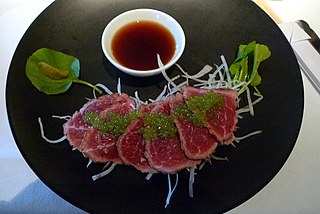
Ponzu
Ponzu (ポン酢) is a citrus-based sauce commonly used in Japanese cuisine. It is tart, with a thin, watery consistency. Ponzu shōyu or ponzu jōyu (ポン酢醤油) is ponzu with soy sauce (shōyu) added, and the mixed dark brown product is widely referred to as simply ponzu.
The term originally came into the Japanese language as ponsu as a borrowing of the now obsolete Dutch word pons, meaning punch as in a beverage made from fruit juices. The sour nature of this sauce led to the final -su being written with the character su (酢), meaning "vinegar".
Ponzu is made by simmering mirin, rice vinegar, katsuobushi flakes (from tuna), and seaweed (kombu) over medium heat. The liquid is then cooled, strained to remove the katsuobushi flakes, and finally the juice of one or more of the following citrus fruits is added: yuzu, sudachi, daidai, kabosu, or lemon.
Commercial ponzu is generally sold in glass bottles, which may have some sediment. Ponzu shōyu is traditionally used as a dressing for tataki (lightly grilled, then chopped meat or fish) and also as a dip for nabemono (one-pot dishes) such as shabu-shabu. It is used as a dip for sashimi. In the Kansai region, it is offered as a topping for takoyaki.
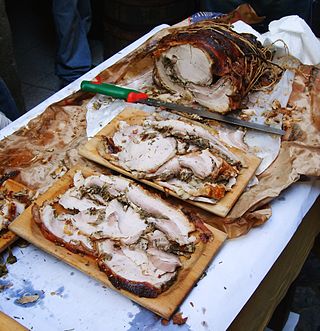
Porchetta
Porchetta (Italian pronunciation: [porˈketta]) or Porquette in France, is a savory, fatty, and moist boneless pork roast from Italy and the French region of Nice. The carcass is deboned and spitted or roasted traditionally over wood for at least eight hours, fat and skin still on. In some traditions, porchetta is stuffed with liver and wild fennel, though many versions do not involve stuffing. Porchetta is usually heavily salted and can be stuffed with garlic, rosemary, fennel, or other herbs, often wild. Porchetta has been selected by the Italian Ministry of Agricultural, Food and Forestry Policy as a prodotto agroalimentare tradizionale ("traditional agricultural-food product"), one of a list of traditional Italian foods held to have cultural relevance.

Potsticker
Jiaozi (Chinese: 餃子; [tɕjàʊ.tsɨ] ) are a type of Chinese dumpling. Jiaozi typically consist of a ground meat and/or vegetable filling wrapped into a thinly rolled piece of dough, which is then sealed by pressing the edges together. Finished jiaozi can be boiled (shuǐ jiǎo), steamed (zhēng jiǎo), pan fried (jiān jiǎo), or deep fried (zhá jiǎo), and are traditionally served with a black vinegar and sesame oil dip. They can also be served in a soup (tāng jiǎo).
Jiaozi have great cultural significance attached to them within China. Jiaozi are one of the major dishes eaten during the Chinese New Year throughout northern China and eaten all year round in the northern provinces. Their resemblance to the gold and silver ingots (sycee) used in Imperial China has meant that they symbolize wealth and good fortune. Though considered part of Chinese cuisine, jiaozi are also popular in other parts of East Asia, where a Japanese variety is referred to as gyoza, and in the Western world, where a fried variety is referred to as potstickers. The English-language term "potsticker" was invented by Buwei Yang Chao in her book How to Cook and Eat in Chinese (1945).

Poutine
Poutine (Quebec French: [put͡sɪn] ) is a dish of french fries and cheese curds topped with a brown gravy. It emerged in Quebec, in the late 1950s in the Centre-du-Québec region, though its exact origins are uncertain and there are several competing claims regarding its invention. For many years, it was used by some to mock Quebec society. Poutine later became celebrated as a symbol of Québécois culture and the province of Quebec. It has long been associated with Quebec cuisine, and its rise in prominence has led to its growing popularity throughout the rest of Canada.
Annual poutine celebrations occur in Montreal, Quebec City, and Drummondville, as well as Toronto, Ottawa, New Hampshire, and Chicago. It has been called Canada's national dish, though some critics believe this labelling represents cultural appropriation of the Québécois or Quebec's national identity. Many variations on the original recipe are popular, leading some to suggest that poutine has emerged as a new dish classification in its own right, as with sandwiches and dumplings.

Pozole
Pozole (Spanish pronunciation: [po'sole]; from Nahuatl languages: pozolli, meaning cacahuazintle, a variety of corn or maize) is a traditional soup or stew from Mexican cuisine. It is made from hominy with meat (typically chicken or pork), and can be seasoned and garnished with shredded lettuce or cabbage, chilli peppers, onion, garlic, radishes, avocado, salsa or limes. Known in Mesoamerica since the pre-Columbian era, the stew is common across Mexico and neighboring countries, served both as a day-to-day meal and as a festive dish.

Puttanesca
Spaghetti alla puttanesca (Italian: [spaˈɡetti alla puttaˈneska]) is an Italian pasta dish invented in Naples in the mid-20th century and made typically with tomatoes, olive oil, olives, anchovies, chili peppers, capers, and garlic, with vermicelli or spaghetti pasta.

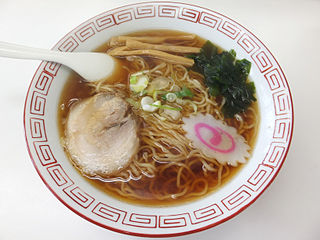
Ramen
Ramen () (拉麺, ラーメン or らーめん, rāmen, [ɾaꜜːmeɴ] ) is a Japanese noodle dish. It consists of Chinese-style wheat noodles (中華麺, chūkamen) served in a broth; common flavors are soy sauce and miso, with typical toppings including sliced pork (chāshū), nori (dried seaweed), menma (bamboo shoots), and scallions. Ramen has its roots in Chinese noodle dishes and is a part of Japanese Chinese cuisine. Nearly every region in Japan has its own variation of ramen, such as the tonkotsu (pork bone broth) ramen of Kyushu and the miso ramen of Hokkaido.
The origins of ramen can be traced back to Yokohama Chinatown in the early 20th century. The word "ramen" is a Japanese borrowing of the Chinese word lamian (拉麵), meaning "pulled noodles", but the dish evolved from southern Chinese noodle dishes, reflecting the demographics of Chinese settlers in Yokohama. Ramen gained popularity in Japan, especially during food shortages following World War II. In 1958, instant noodles were invented by Momofuku Ando, further popularizing the dish.
Today, ramen is a cultural icon in Japan, with many regional varieties and a wide range of toppings. Examples include Sapporo's rich miso ramen, Hakodate's salt-flavored ramen, Kitakata's thick, flat noodles in pork-and-niboshi broth, Tokyo-style ramen with soy-flavored chicken broth, Yokohama's Iekei Ramen with soy flavored pork broth, Wakayama's soy sauce and pork bone broth, and Hakata's milky tonkotsu (pork bone) broth. Ramen is offered in various establishments and locations, with the best quality usually found in specialist ramen shops called ramenya (ラーメン屋).
Ramen's popularity has spread outside of Japan. In Korea, ramen is known as ramyeon (라면). In China, ramen is called rìshì lāmiàn (日式拉麵 "Japanese-style lamian"). Ramen has also made its way into Western restaurant chains. Instant ramen was exported from Japan in 1971 and has since gained international recognition.
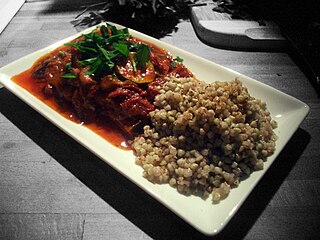
Ratatouille
Ratatouille ( RAT-ə-TOO-ee, French: [ʁatatuj] ; Occitan: ratatolha [ʀataˈtuʎɔ] ) is a French Provençal dish of stewed vegetables that originated in Nice and is sometimes referred to as ratatouille niçoise (French: [niswaz]). Recipes and cooking times differ widely, but common ingredients include tomato, garlic, onion, courgette (zucchini), aubergine (eggplant, brinjal), capsicum (bell pepper), and some combination of leafy green herbs common to the region.

Rémoulade
Rémoulade (English: ; French: [ʁemulad]) is a cold sauce. Although similar to tartar sauce, it is often more yellowish, sometimes flavored with curry, and often contains chopped pickles or piccalilli. It can also contain horseradish, paprika, anchovies, capers and a host of other items.
While its original purpose was possibly for serving with meats, it is now more often used as a condiment or dipping sauce, primarily for sole, plaice, and seafood cakes (such as crab or salmon cakes).

Risotto
Risotto is an Italian rice dish cooked with broth until it reaches a creamy consistency. The broth can be derived from meat, fish, or vegetables. Many types of risotto contain butter, onion, white wine, and Parmesan cheese. It is one of the most common ways of cooking rice in Italy. Saffron was originally used for flavour and its signature yellow colour.
Risotto in Italy is often a first course served before a second course, but risotto alla milanese is often served with ossobuco alla milanese as a one-course meal.

Romesco
Romesco (Catalan pronunciation: [ruˈmɛsku]) is a tomato-based sauce that originated from Valls, province of Tarragona, in Catalonia, Spain. The fishermen in this area made this sauce to be eaten with fish. It is typically made from any mixture of roasted tomatoes and garlic, toasted almonds, pine nuts, and/or hazelnuts, olive or sunflower oil, and nyora peppers (capsicum annuum, a sun-dried, small, round variety of red bell pepper). Flour or ground stale bread may be used as a thickener or to provide texture.
Other common ingredients include sherry vinegar, red wine vinegar, and onions. Leaves of fennel or mint may be added, particularly if served with fish or escargot. It is very often served with seafood, but can also be served with a wide variety of other foods, including poultry, some red meats like lamb, and vegetables.
According to food writer Melissa Clark, cookbook author Penelope Casas was considered the recognized authority on romesco recipes for English-speaking readers. When touring Catalonia, though, Clark discovered that there was no single correct recipe and encountered several variations. Clark described romesco as "a rich and piquant purée made from sweet dried Spanish peppers along with tomato, garlic, almonds, vinegar, and oil, pounded with breadcrumbs as a binder." Some variations were thick, others were thin, and one substituted crushed almond biscotti for the almonds and bread crumbs and incorporated hard-boiled eggs. Clark's version uses hazelnuts instead of almonds.
Romesco sauce is often confused with similar sauces, particularly salsa de calçots or salvitxada. During the springtime, salsa de calçots is served as an accompanying dip for calçots, a spring onion typical to Catalonia, during traditional springtime calçot barbecues called "calçotades." During calçotades, calçots are roasted over an open fire until their outer layer is charred. The charred layer is then removed, and the tender part of the onion may be dipped into the sauce.
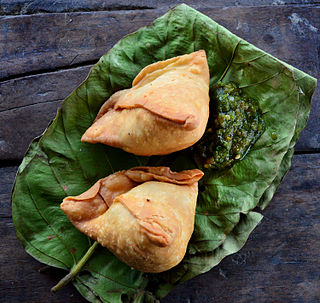
Samosa
A samosa () () is a fried South Asian pastry with a savoury filling, including ingredients such as spiced potatoes, onions, peas, meat, or fish. It may take different forms, including triangular, cone, or half-moon shapes, depending on the region. Samosas are often accompanied by chutney, and have origins in medieval times or earlier. Sweet versions are also made. Samosas are a popular entrée, appetizer, or snack in the cuisines of South Asia, the Middle East, Central Asia, East Africa and their South Asian diasporas.

Sashimi
Sashimi (刺身, English: sə-SHEE-mee, Japanese: [saɕimiꜜ]) is a Japanese delicacy consisting of fresh raw fish or meat sliced into thin pieces and often eaten with soy sauce.

Sauerkraut
Sauerkraut (; German: [ˈzaʊ.ɐˌkʁaʊt] , lit. 'sour cabbage') is finely cut raw cabbage that has been fermented by various lactic acid bacteria. It has a long shelf life and a distinctive sour flavor, both of which result from the lactic acid formed when the bacteria ferment the sugars in the cabbage leaves.
Although it is considered a national dish in Germany and is known under its German name in English-speaking countries, it did not originate in Germany and is also a traditional and ubiquitous dish in Central and Eastern Europe.
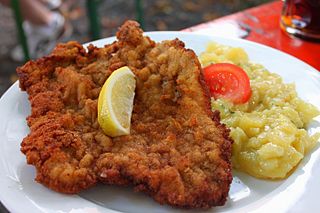
Schnitzel
A schnitzel (German: [ˈʃnɪt͡sl̩] ) is a thin slice of meat. The meat is usually thinned by pounding with a meat tenderizer. Most commonly, the meat is breaded before frying. Breaded schnitzel is popular in many countries and is made using veal, pork, chicken, mutton, beef, or turkey. Schnitzel is very similar to the dish escalope in France and Spain, panado in Portugal, tonkatsu in Japan, cotoletta in Italy, kotlet schabowy in Poland, milanesa in Latin America, chuleta valluna in Colombia, chicken chop in Malaysia, and chicken-fried steak and pork tenderloin of the United States.

Shakshouka
Shakshouka (Arabic: شكشوكة : šakšūkah, also spelled shakshuka or chakchouka) is a Maghrebi dish of eggs poached in a sauce of tomatoes, olive oil, peppers, onion, and garlic, commonly spiced with cumin, paprika and cayenne pepper. According to Joan Nathan, shakshouka originated in Ottoman North Africa in the mid-16th century after tomatoes were introduced to the region by Hernán Cortés as part of the Columbian exchange. Shakshouka is a popular dish throughout the Middle East and North Africa.

Shawarma
Shawarma (; Arabic: شاورما) is a Levantine dish that originated in the Ottoman Empire. It consists of meat that is cut into thin slices, stacked in an inverted cone, and roasted on a slow-turning vertical spit. Traditionally made with lamb or mutton, it may also be made with chicken, turkey, beef, or veal. The surface of the rotisserie meat is routinely shaved off once it cooks and is ready to be served. Shawarma is a popular street food throughout the Arab world and the Greater Middle East. It was popularized in the Western world after being introduced by the Lebanese diaspora.

Shepherd's Pie
Shepherd's pie, cottage pie, or in its French version hachis Parmentier, is a savoury dish of cooked minced meat topped with mashed potato and baked, formerly also called Sanders or Saunders. The meat used may be either previously cooked or freshly minced. The usual meats are beef or lamb. The two English terms have been used interchangeably since they came into use in the late 18th and early 19th centuries, although some writers insist that a shepherd's pie should contain lamb or mutton, and a cottage pie, beef.

Smørrebrød
Smørrebrød (Danish pronunciation: [ˈsmɶɐ̯ˌpʁœðˀ]; originally smør og brød, "butter and bread"), smørbrød "butter bread" (Norwegian), or smörgås "butter goose" (Swedish), is a traditional open-faced sandwich in the cuisines of Denmark, Norway and Sweden that usually consists of a piece of buttered rye bread (rugbrød, a dense, dark brown bread), topped with commercial or homemade cold cuts, pieces of meat or fish, cheese or spreads, and garnishes.

Soufflé
A soufflé is a baked egg dish originating in France in the early 18th century. Combined with various other ingredients, it can be served as a savoury main dish or sweetened as a dessert. The word soufflé is the past participle of the French verb souffler, which means to blow, breathe, inflate or puff.
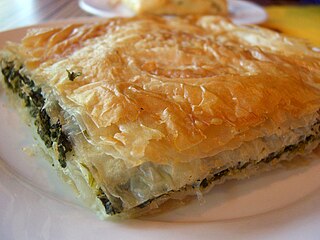
Spanakopita
Savory spinach pie is a pastry eaten throughout the Balkans. The filling is made of chopped spinach (sometimes chard) and usually feta or white cheese, and egg.

Spätzle
Spätzle ([ˈʃpɛtslə] ), or nokedli in Hungarian, are a type of Central European egg noodles typically served as a side for meat dishes with sauce. Commonly associated with Swabia and Alsace, it is also found in the cuisines of southern Germany and Austria, Switzerland, Hungary, Vojvodina, Slovenia, Lorraine, Moselle and South Tyrol.

Sweetbread
Sweetbread is a culinary name for the thymus (also called throat, gullet, or neck sweetbread) or pancreas (also called stomach, belly or heart sweetbread), typically from calf (French: ris de veau) or lamb (ris d'agneau). Sweetbreads have a rich, slightly gamey flavor and a tender, succulent texture. They are often served as an appetizer or a main course and can be accompanied by a variety of sauces and side dishes.
The "heart" sweetbreads are more spherical, while the "throat" sweetbreads are more cylindrical. As the thymus is replaced by fibrous tissue in older animals, only pancreatic sweetbreads come from beef and pork. Like other edible non-muscle from animal carcasses, sweetbreads may be categorized as offal, "fancy meat", or "variety meat".: 4,23 Various other glands used as food may also sometimes be called "sweetbreads", including the parotid gland ("cheek" or "ear" sweetbread), the sublingual glands ("tongue" sweetbreads or "throat bread") as well as ovary and testicles.
Sweetbreads are a part of traditional French cuisine. In Henri-Paul Pellaprat's classic Modern French Culinary Art, which was published in English in 1966, he includes six different recipes for sweetbreads, including versions with cream sauce, with ham, presented in pastry cases, and à la Florentine. In the 1961 classic, Mastering the Art of French Cooking: Volume 1, Julia Child and her co-authors also include six recipes for sweetbreads, with variations of cream and mushroom sauces, a version à l’Italienne including ham and mushrooms, and a gratin with Swiss cheese.
In a cookbook published in 1949, American chef James Beard included recipes for sweetbreads en brochette, broiled sweetbreads, and three variations of sautéed sweetbreads.
Sweetbreads are a component of the Creole cuisine of Louisiana, with recipes included in some of the earliest cookbooks published there. Many restaurants in New Orleans serve sweetbreads.
Sweetbread is a common Iranian street food and is often served as a kebab. One common preparation of sweetbreads involves soaking in salt water, then poaching in milk, after which the outer membrane is removed. Once dried and chilled, they are often breaded and fried. They are also used for stuffing or in pâtés. They are grilled in many Latin American cuisines, such as in the Argentine asado, floured and pan-fried in Greece (sheep's thymus is usually used), and served in bread in Turkish cuisine.
The word sweetbread is first attested in the 16th century, but the etymology of the name is unclear. Sweet is perhaps used since the thymus is sweet and rich-tasting, as opposed to savory-tasting muscle flesh. Bread may come from Middle English brede, meaning 'roast meat'.

Tabbouleh
Tabbouleh (Arabic: تبولة, romanized: tabbūla), also transcribed tabouleh, tabbouli, tabouli, or taboulah, is a Levantine salad made mostly of finely chopped parsley, with tomatoes, mint, onion, soaked uncooked bulgur, and seasoned with olive oil, lemon juice, salt and sweet pepper. Some variations add lettuce, or use semolina instead of bulgur.
Tabbouleh is traditionally served as part of a mezze in the Eastern Mediterranean and the Arab world. Like hummus, baba ghanoush, pita bread, and other elements of Arab cuisine, tabbouleh has become a popular food in the United States.

Tahdig
Scorched rice, also known as crunchy rice, is a thin crust of slightly browned rice at the bottom of the cooking pot. It is produced during the cooking of rice over direct heat from a flame.
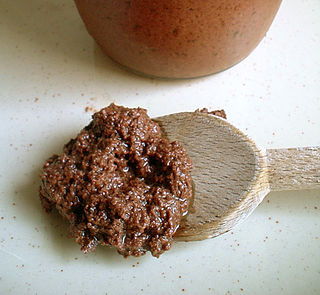
Tapenade
Tapenade (French pronunciation: [tapəˈnad]; Occitan: tapenada [tapeˈnadɔ]) is a Provençal name for a spread, condiment and culinary ingredient consisting of puréed or finely chopped olives, capers, and sometimes anchovies. Vegan versions that are available commercially do not contain anchovies. Tapenade's name comes from the Provençal word for capers, tapenas (pronounced [taˈpenɔs]). It is a popular food in the south of France, where it is generally eaten as an hors d'œuvre spread on bread, with fish, in salads, and sometimes used to stuff poultry for the main course.

Tartare
Steak tartare or tartar steak is a French dish of raw ground (minced) beef. It is usually served with onions, capers, mushrooms, pepper, Worcestershire sauce, and other seasonings, often presented separately, to be added to taste. It is often served topped with a raw egg yolk. It is similar to the Levantine kibbeh nayyeh, the Turkish çiğ köfte and the Korean yukhoe.
The name tartare is sometimes generalized to other raw meat or fish dishes. In France, a less-common variant called tartare aller-retour is a mound of mostly raw ground meat lightly seared on both sides.

Teriyaki
Teriyaki (Kanji: 照り焼き) is a cooking technique in which foods are broiled or grilled with a glaze of soy sauce, mirin, and sugar. Although commonly associated with Japanese cuisine, this cooking technique is also commonly used in other Asian cuisines such as Chinese cuisine, Indonesian cuisine and Thai cuisine.
Fish – yellowtail, marlin, skipjack tuna, salmon, trout, and mackerel – is mainly used in Japan, while white and red meat – chicken, pork, lamb, and beef – is more often used in the West. Other ingredients sometimes used in Japan include squid, hamburger steak, and meatballs.
The word teriyaki derives from the noun teri (照り), which refers to a shine or luster given by the sugar content in the tare (タレ), and yaki (焼き), which refers to the cooking method of grilling or broiling. Traditionally the meat is dipped in or brushed with sauce several times during cooking. It is believed that Teriyaki in Japan evolved during the 1600s.
The tare (タレ) is traditionally made by mixing and heating soy sauce, sake (or mirin), and sugar (or honey). The sauce is boiled and reduced to the desired thickness, then used to marinate meat, which is then grilled or broiled. Sometimes ginger is added and the final dish may be garnished with spring onions.
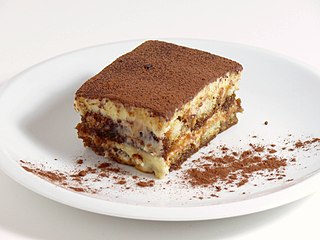
Tiramisu
Tiramisu is an Italian dessert made of ladyfingers (savoiardi) dipped in coffee, layered with a whipped mixture of eggs, sugar and mascarpone and flavoured with cocoa. The recipe has been adapted into many varieties of cakes and other desserts. Its origin is disputed between the Italian regions of Veneto and Friuli-Venezia Giulia. The name comes from the Italian tirami su (lit. 'pick me up' or 'cheer me up').

Tzatziki
Tzatziki (Greek: τζατζίκι, tzatzíki, [d͡zaˈd͡zici]), also known as cacık (Turkish pronunciation: [dʒaˈdʒɯk]) or tarator, is a class of dip, soup, or sauce found in the cuisines of Southeastern Europe and West Asia. It is made of salted strained yogurt or diluted yogurt mixed with cucumbers, garlic, salt, olive oil, sometimes with vinegar or lemon juice, and herbs such as dill, mint, parsley and thyme. It is served as a cold appetizer (meze), a side dish, and as a sauce for souvlaki and gyros sandwiches and other foods.

Vinaigrette
Vinaigrette ( VIN-ih-GRET, French: [vinɛɡʁɛt] ) is made by mixing an oil with a mild acid such as vinegar or lemon juice (citric acid). The mixture can be enhanced with salt, herbs and/or spices. It is used most commonly as a salad dressing, but can also be used as a marinade. Traditionally, a vinaigrette consists of 3 parts oil and 1 part vinegar mixed into a stable emulsion, but the term is also applied to mixtures with different proportions and to unstable emulsions which last only a short time before separating into layered oil and vinegar phases.
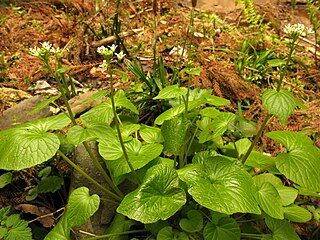
Wasabi
Wasabi (Japanese: ワサビ, わさび, or 山葵, pronounced [waꜜsabi]) or Japanese horseradish ( Eutrema japonicum syn. Wasabia japonica) is a plant of the family Brassicaceae, which also includes horseradish and mustard in other genera. The plant is native to Japan and the Russian Far East including Sakhalin, as well as the Korean Peninsula.: 133 It grows naturally along stream beds in mountain river valleys in Japan.
It is grown for its rhizomes which are ground into a paste as a pungent condiment for sushi and other foods. It is similar in taste to hot mustard or horseradish rather than chilli peppers in that it stimulates the nose more than the tongue, but freshly grated wasabi has a subtly distinct flavour.: 53 The two main cultivars in the marketplace are E. japonicum 'Daruma' and 'Mazuma', but there are many others.
The oldest record of wasabi as a food dates to the 8th century AD. The popularity of wasabi in English-speaking countries has coincided with that of sushi, growing steadily starting in about 1980. Due to constraints that limit the Japanese wasabi plant's mass cultivation and thus increase its price and decrease availability outside Japan, the western horseradish plant is widely used in place of the Japanese wasabi. This version is commonly referred to as "western wasabi" (西洋わさび) in Japan.

Waterzooi
Waterzooi is a stew dish from Belgium and originating in Flanders. The second part of the name derives from the Middle Dutch terms sode, zo(o)de and soot, words referring to the act of boiling or the ingredients being boiled. It is sometimes called Gentse Waterzooi which refers to the Belgian town of Ghent where it originated. The original dish is often made of fish, either freshwater or sea, (known as Viszooitje), though today chicken waterzooi (Kippenwaterzooi) is more common. The most accepted theory is that rivers around Ghent became too polluted and the fish there disappeared. Charles V, Holy Roman Emperor ate the rich dish, even after suffering from gout.